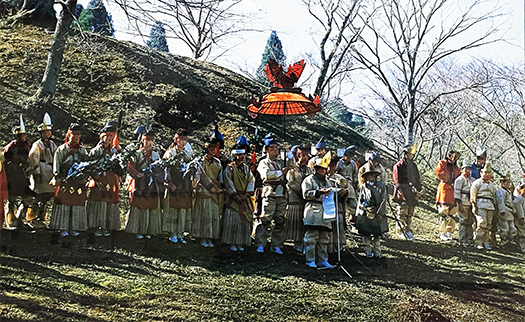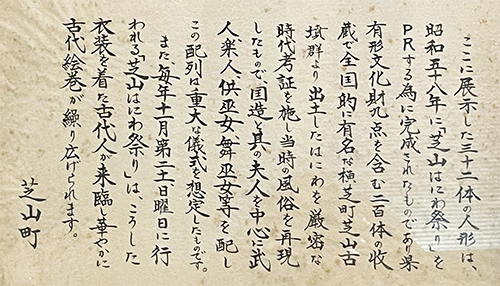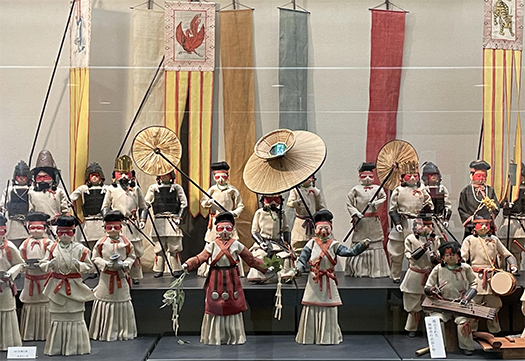


古墳に祀られた古代における族長たちというものがどんな存在であったか、そういうテーマに具体的に取り組んでいるのが、この千葉県芝山町の一連の活動。そのなかでも年に一度、「芝山はにわまつり」というイベントを継続してきている活動は、すばらしくエネルギッシュなものと思います。
不勉強でこういう活動があることを現地の博物館に来てみて初めて知った次第。2023年11月12日、38回目を迎える芝山はにわ祭が5年ぶりに通常開催されたということ。地元の小中学生などが古代人に扮し、殿塚姫塚古墳、芝山仁王尊、芝山公園などで儀式を行ったのだという。地元の子どもたちも参加していることが喜ばしい。地域の歴史へのリスペクトを涵養する試みだと思います。
2枚目の写真にその概要が記されていますが、発掘されたはにわを復元すると同時に、それをもとにして厳密に時代考証を施して「当時の風俗を再現」とあります。
先般ご紹介した千葉県にある「国立歴史民俗博物館」での石器時代のジオラマでの迫真の家族像など、こういった「その時代の空気感」にきわめて具体的に関係する「どんな服を着ていたのか」というファッションの世界にまで迫っていく考古的研究はすばらしいと思います。石器時代とは言え、人間の本性から発露する女性の「美の探求」は時代を超えた普遍的な価値観でしょう。
わたしたち一般の人間にとって、こういうビジュアル化は、非常に具体的な想像力をわかりやすく喚起してくれる。テキスト・文章だけではイマイチ響いてこないものが、強烈な印象で覚醒させられる。

きのう触れたように、古墳はその被葬者として具体的には「国造〜くにのみやっこ」と呼ばれる地域権力者が想定される。地図表記されていたものから判読すると「武射〜むさ」の国造という存在が具体的に浮かび上がってくる。1500年ほどの時空を超えて、リアリティが蘇ってくる次第。
地域権力の継承と、その即位礼は「まつり」というもののある始原を垣間見させてくれる。このような「通過儀礼」を多くの民人に印象づけることで、支配と被支配の関係にある種の「合意」を成立させている。まつりごと、というコトバはその始原において「祭政」という両面性を持ったものだった。
千葉県芝山町は、このような古墳発掘という契機をとらえて、なかなかに革新的・挑戦的なこころみを仕掛けていると思います。想像するに成田空港という国家的なプロジェクトがこういった活動のバックグラウンドを形成したと言えるのかも知れませんね。
English version⬇
Visualization of Ancient “Kokuzo” Power: Exploring Chiba Shibayama Kofun Tumulus – 3
There are many ancient burial mounds in Japan, but this restoration of the fashion of the time and events with the participation of local elementary and junior high school students are also a part of the project. This is the vitality of the region. Chiba, Japan
The town of Shibayama in Chiba Prefecture is engaged in a series of activities that specifically address the theme of what ancient chiefs enshrined in ancient burial mounds might have been like. Among them, the “Shibayama Haniwa Festival” held once a year is one of the most energetic activities that the town has continued.
I was unaware of these activities until I visited the local museum, where I learned that on November 12, 2023, the 38th Shibayama Haniwa Festival was held for the first time in five years. Local elementary and junior high school students and others dressed up as ancient people and held ceremonies at the Tonozuka-Himezuka Kofun Tomb, Shibayama Niozonzon, Shibayama Park, and other locations. We were pleased to see that local children also participated in the event. I think this is an attempt to cultivate respect for local history.
The second photo shows the outline of the project. It says that, as well as restoring the excavated haniwa, it will “reproduce the customs of the time” by conducting a rigorous period study based on it.
I think it is wonderful that archaeological research is approaching the world of fashion, such as the diorama of the Stone Age at the National Museum of Japanese History in Chiba Prefecture, which I recently introduced, showing a realistic image of a family, and what kind of clothes people wore, which is very concretely related to the “atmosphere of the period. Even in the Stone Age, women’s search for beauty, which emanates from human nature, is a universal value that transcends time.
For us ordinary people, this kind of visualization evokes a very concrete imagination in an easy-to-understand way. What is not so clear in the text alone is awakened with a powerful impression.
As I mentioned yesterday, the burial mounds are supposed to be inhabited by a local authority called “Kunizo” or “Kuninomyakko. The map of the tombs reveals the existence of the Kunizo of Musa, which brings back a sense of reality beyond the time and space of about 1,500 years.
The succession of regional power and the coronation rites give us a glimpse of the origins of the festival. By impressing the people with such a “rite of passage,” a kind of “agreement” is established in the relationship between the rulers and the ruled. The word “matsurimono,” in its original sense, had a two-sided nature as a “rite of passage.
The town of Shibayama, Chiba Prefecture, has taken the opportunity of excavating such a burial mound and has come up with a very innovative and challenging idea. I imagine that the national project of Narita Airport may have formed the background for this kind of activity.
Posted on 12月 1st, 2023 by 三木 奎吾
Filed under: 日本社会・文化研究, 歴史探訪







コメントを投稿
「※誹謗中傷や、悪意のある書き込み、営利目的などのコメントを防ぐために、投稿された全てのコメントは一時的に保留されますのでご了承ください。」
You must be logged in to post a comment.